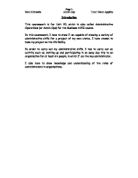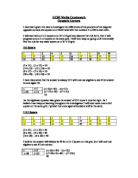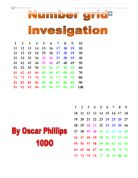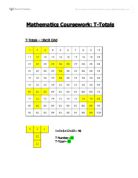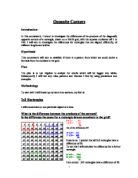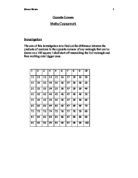The aim of this investigation is to find a relationship between the T-total and T-numbers. First by using a 9 by 9 number grid and then by changing the grid size.
Aim: The aim of this investigation is to find a relationship between the T-total and T-numbers. First by using a 9 by 9 number grid and then by changing the grid size. Method: I will first draw out a 9 by 9 grid and put Ts within it. I will place my results into a table and attempt to find a relationship between the two. I will incorporate this relationship into a rule using letters and numbers only. I will then do the similar thing for a 4 by 4, 5 by 5, 6 by 6 and 7 by 7 grid also. I will then try to find an overall rule to work out any grid size T-totals: I am going to do some T-totals and put the answers into tables. The first grid I am going to do is a 9 by 9 grid. 2 3 4 5 6 7 8 9 0 1 2 3 4 5 6 7 8 9 20 21 22 23 24 25 26 27 28 29 30 31 32 33 34 35 36 37 38 39 40 41 42 43 44 45 46 47 48 49 50 51 52 53 54 55 56 57 58 59 60 61 62 63 64 65 66 67 68 69 70 71 72 73 74 75 76 77 78 79 80 81 Table: This table shows all the T-numbers and T-totals possible in a 9 by 9 grid up to a T-number of 40. I have worked the T-totals out by drawing Ts in the grid and adding up the numbers within each T. T-number T-total 20 37 21 42 22 47 23 52 24 57 25 62 26 67 29 82 30 87 31 92 32 97 33 02 34 07 35 12 38 27 39 32 40 37 Prediction: I have found that there is a
Number stairsMy aim is to investigate the relationship between the stair total and the position of the stair shape on the grid for 3 step
Number stairs My aim is to investigate the relationship between the stair total and the position of the stair shape on the grid for 3 step stairs and to investigate further the relationship between the stair totals and other step stairs on other number grids. 91 92 93 94 95 96 97 98 99 00 81 82 83 84 85 86 87 88 89 90 71 72 73 74 75 76 77 78 79 80 61 62 63 64 65 66 67 68 69 70 51 52 53 54 55 56 57 58 59 60 41 42 43 44 45 46 47 48 49 50 31 32 33 34 35 36 37 38 39 40 21 22 23 24 25 26 27 28 29 30 1 2 3 4 5 6 7 8 9 20 2 3 4 5 6 7 8 9 0 To begin I will try to identify a pattern. Taking my example I will take all the three stair steps on the bottom row and see if there are any similarities between the results. ) 1+2+3+11+12+21=50 2) 2+3+4+12+13+22=56 3) 3+4+5+13+14+23=62 4) 4+5+6+14+15+24=68 5) 5+6+7+15+16+25=74 6) 6+7+8+16+17+26=80 7) 7+8+9+17+18+27=86 8) 8+9+10+18+19+28=92 Therefore I can now find a formula. The general term for an arithmetic sequence is Un=ab+c. The terms go up in sixes and this tells me that the nth term will include 6 lots of n or 6n. For the first term n=1, so 6n=6. But the first term is 50 which is 44 more than 6n. This suggests that the formula is 6n+44. Trying a few values of n will help prove that my formula is correct. (6 multiplied by 1) +44
This project consists of the investigation between patterns between T-numbers and T-totals.
* Investigation * Introduction This project consists of the investigation between patterns between T-numbers and T-totals. My investigation consists of different aims, but all of these aims have to do with this mathematical "T". I believe that there is a direct link between these two, as the T-total increases depending on the T-number. I think that there is nth sequence relating the T-number and the T-total, and therefore I will try and investigate this. First, I will use a 9 by 11 grid and find the relationship between the T-number, and the T-total in this grid. I will draw other girds and also find out the correlation between the translation of T-numbers, T-totals and the gird size. After this, I will go back to my initial 9 by 11 grid, and rotate the "T" and try to find the possible relationship of T-numbers and T-total of the rotated "T". I believe that there is a formula for the T-total of T-shapes in any grid and in any rotation. Subsequent to this investigation, I will use and enlargement of my initial "T" and use different examples to show the relationship between the enlargement and the T-number and T-total. From all my different investigations I will draw my conclusions giving explications for these. * Method: Task I. . I will draw a 9 by 11 grid, where I will select a T-shape, and transform it to form as many T-numbers and T-totals as possible, to see a
admin in business
Introduction This coursework is for Unit 20, which is also called Administrative Operations (or Admin Ops) for the Business AVCE course. In this coursework, I have to show I' am capable of showing a variety of administrative skills for a project of my own choice. I have chosen to base my project on the Old Bailey. In order to carry out my administrative skills, I had to carry out an activity such as, setting up and participating in an away day trip to an organisation for at least six people, in which I' am the key administrator. I also have to show knowledge and understanding of the roles of administrators in organisations. In this coursework I' am required to work in a group of people that have specific roles in the group and plan and organize (or administer) our own event for AVCE Business Studies Year 2, unit 20 - Admin Ops. Our event has to be well planned and multi-layered, as this will allow each individual in the group to act out their role. My group is built up of 6 people. They are, Rachel, Chris, Sophie, Asif, Ashraf and me. We have all worked together in Unit 1 (Business At Work) and have all obtained experience of producing information. Examples are in, Unit 3, 4 and 10 (Marketing, HR and Customer Service). We all set each other positions or roles in the group in order to get our event started up. Below are my group's roles/positions. * Rachel - Boss *
For this coursework - stair shape - I am going to investigate the relationship between the stair total and the position of the stair shape on the grid. To do this I am going to create tables, charts, graphs, algebra equations and try to find the n'th ter
GCSE Maths Coursework. 'Stair shape' Introduction For this coursework 'stair shape' I am going to investigate the relationship between the stair total and the position of the stair shape on the grid. To do this I am going to create tables, charts, graphs, algebra equations and try to find the n'th term. I am also going to investigate the relationship between the stair totals and other step stairs on the other number grids. Plan I plan to draw different stair shapes on a grid, and then show my finding in a table format. I also plan to show my working outs, and my method of my data capture. Once I have done this I will predicate the n'th term then test to see if my formula works. Data This data that I have collected was from a 10, by 10 grids. The data is presented in a table below. Number inside stair Shape Stair Total +2+3+11+12+21 21 1 2 2 3 50 6 2+3+4+12+13+22 56 22 2 3 2 3 4 6 3+4+5+13+14+23 62 23 3 4 3 4 5 6 4+5+6+14+15+24 68 24 4 5 4 5 6 *Number in Red is the different that the Stair total is going up in. Conclusion From the data I have collected I found that if the stair shape moves across the bottom of the grid the stair total will increase by 6. If I move the stair shape across the middle of the 10, by 10 grid the stair total should also increase by 6. Number inside stair Shape Stair Total 33+34+35+43+44+53 53 43
T-Totals. To figure out an equation for different grid sizes, I have to find the relationship between grid sizes and the T total. I will now let S= Grid Size.
2 3 4 5 6 7 8 9 0 1 2 3 4 5 6 7 8 9 20 21 22 23 24 25 26 27 28 29 30 31 32 33 34 35 36 37 38 39 40 41 42 43 44 45 46 47 48 49 50 51 52 53 54 55 56 57 58 59 60 61 62 63 64 65 66 67 68 69 70 71 72 73 74 75 76 77 78 79 80 81 T-Totals Part 1 By using algebra I can find the equation for T Total for grid size 9 T Total= n-19+n-18+n-17+n-9+n= 5n-63 T Total= 5n-63 is the relationship between the T total and the T number. This means for example that if the T number is 20 my formula predicts a T Total of 5× 20- 63= 37 which agrees with my earlier calculations. Part 2 Equation for different grid sizes To figure out an equation for different grid sizes, I have to find the relationship between grid sizes and the T total. I will now let S= Grid Size. I get this T T Total= n+n-S+n-2S+n-2S+1+n+2S-1= 5n-7S This means that the equation is T total= 5n-7S where S is the grid size so if for example the T number is 24 and the grid size is 11 then the T total will be (5× 24- 11× 7)= 43. I can check whether this works. 2 3 4 5 6 7 8 9 0 1 2 3 4 5 6 7 8 9 20 21 22 23 24 25 26 27 28 29 30 31 32 33 34 35 36 37 38 39 40 41 42 43 44 45 46 47 48 49 50 51 52 53 54 55 56 57 58 59 60 61 62 63 64 65 66 67 68 69 70 71 72 73 74 75 76 77 78
My Investigation is called 'Number Stairs'
Mathematics Coursework Number stairs My Investigation is called 'Number Stairs' Task Statement I have been set the task of working out the relationship between a three-stair total and the position of the stair shape on the prearranged grid and other stair totals. For further investigation other stair totals could be worked out on different grids of our own and also different numbers of stairs other than three. The rules for my investigation are: . Each stair is labelled as a number; this number is the bottom left hand number of that stair. This is known as the keystone. 2. You will work horizontally across the grid from square number one. 3. If you come to a stair total on the edge of a grid this is what you should do: 91 92 93 94 95 96 97 98 99 00 81 82 83 84 85 86 87 88 89 90 71 72 73 74 75 76 77 78 79 80 61 62 63 64 65 66 67 68 69 70 51 52 53 54 55 56 57 58 59 60 41 42 43 44 45 46 47 48 49 50 31 32 33 34 35 36 37 38 39 40 21 22 23 24 25 26 27 28 29 30 1 2 3 4 5 6 7 8 9 20 2 3 4 5 6 7 8 9 0 This is, if it was not on the edge: 40 30 31 20 21 22 Aim As I work through this task I hope to find a formula that will help me to work out any stair total on any grid. Method To start with I will work out the stairs going across. This, after working a few stairs a pattern
A Square Investigation
A SQUARE INVESTIGATION Aim: The aim of this investigation is to find any rules, patterns of square numbers. Patterns/ rules will be discussed step by step below. Firstly a square number is a number multiplied by it. The name becomes apparent if one looks at a diagram of a square. e.g. 2^2 = 2*2= 4sq units; we say 4 is the square of 2. Hence a square number gives the area of a square. Method: the first step was to draw the table below. (Explain what each column means, draw a graph). X NUMBER X^2 SQUARE NO. OF TENS DIFFERENCE NO. OF UNITS 0 0 0 0 0 0 2 4 0 0 4 3 9 0 0 9 4 6 6 5 25 2 5 6 36 3 6 7 49 4 9 8 64 6 2 4 9 81 8 2 0 00 0 2 0 1 21 2 2 2 44 4 2 4 3 69 6 3 9 4 96 9 3 6 5 225 22 3 5 6 256 25 3 6 7 289 28 3 9 8 324 32 4 4 9 361 36 4 20 400 40 4 0 21 441 44 4 22 484 48 4 4 23 529 52 4 9 24 576 57 5 6 25 625 62 5 5 26 676 67 5 6 27 729 72 5 9 28 784 78 6 4 29 841 84 6 30 900 90 6 0 31 961 96 6 32 024 02 6 4 33 089 08 6 9 34 156 15 7 6 35 225 22 7 5 36 296 29 7 6 37 369 36 7 9 38 444 44 8 4 39 521 52 8 40 600 60 8 0 41 681 68 8 42 764 76 8 4 43 849 84 8 9 44 936 93 9 6 45 2025 202 9 5 46 2116 211 9 6 47 2209 220 9 9 48 2304 230 0 4 49
Mathematics Layers Coursework
Mathematics Layers Coursework Chris Grindrod 11SRH Introduction: In this investigation I will be investigating the amount combinations there are when there is a set sized grid with x number of squares on it, one cube can fit In to each square but there must also be one empty square. Then another layer of squares can be placed on top of the first layer of squares but the same rules apply and there must be one square that does not have another square placed on top of it. This applies to any number of layers until you are made to or required to stop. On each new layer you have to use one cube than the layer before until you have to stop or are asked to stop at a certain layer. The rules of the investigation are as follows: The number of cubes on the bottom layer is always one less than the number of squares on the grid unless stated otherwise. Each new layer is made with one less cube than the layer underneath it. Each cube must fit exactly in to a square or a cube underneath it. Part One For part one of the investigation I will investigate how many different arrangements of five cubes there are on a six square grid. Method: I am going to draw all the combinations for the specifications above to find out how many combinations there are. Results: There are six combinations for the specifications, this is because no matter were you put the five cubes on the six
Investigate the relationship between different stairs placed in different places in a number square, which is numbered from one to one hundred.
Introduction In this project I am going to investigate the relationship between different stairs placed in different places in a number square, which is numbered from one to one hundred. I will be trying to find a formula to get a total of any stair any place. Example 91 92 93 94 95 96 97 98 99 00 81 82 83 84 85 86 87 88 89 90 71 72 73 74 75 76 77 78 79 80 61 62 63 64 65 66 67 68 69 70 51 52 53 54 55 56 57 58 59 60 41 42 43 44 45 46 47 48 49 50 31 32 33 34 35 36 37 38 39 40 21 22 23 24 25 26 27 28 29 20 1 2 3 4 5 6 7 8 9 20 2 3 4 5 6 7 8 9 0 This is a 3-step stair The total of the numbers in side the stair is 25+26+27+35+36+37+45=194 I will start on a 2-step stair 38 28+29+38=95 28 29 37 37+27+28=92 27 28 36 36+26+27=89 26 27 I have found out that every time you move the two-step stair one to the left the product of the two-step stair goes down by three. This also means that every time you move the two-step stair one to the right the product will go up by three. 23 23+13+14=50 3 14 33 33+23+24=80 23 24 43 43+33+34=110 33 34 I have found out that when you move the stairs up by one the product of the two-step stair goes up by 30. This also means that when you move the two-step stair down by one the product will go down by -30. I have also found out the





